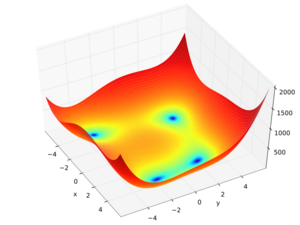Himmelblau's function
From HandWiki
Short description: Function used as a performance test problem for optimization algorithms
In mathematical optimization, Himmelblau's function is a multi-modal function, used to test the performance of optimization algorithms. The function is defined by:
- [math]\displaystyle{ f(x, y) = (x^2+y-11)^2 + (x+y^2-7)^2.\quad }[/math]
It has one local maximum at [math]\displaystyle{ x = -0.270845 }[/math] and [math]\displaystyle{ y = -0.923039 }[/math] where [math]\displaystyle{ f(x,y) = 181.617 }[/math], and four identical local minima:
- [math]\displaystyle{ f(3.0, 2.0) = 0.0, \quad }[/math]
- [math]\displaystyle{ f(-2.805118, 3.131312) = 0.0, \quad }[/math]
- [math]\displaystyle{ f(-3.779310, -3.283186) = 0.0, \quad }[/math]
- [math]\displaystyle{ f(3.584428, -1.848126) = 0.0. \quad }[/math]
The locations of all the minima can be found analytically. However, because they are roots of quartic polynomials, when written in terms of radicals, the expressions are somewhat complicated.[citation needed]
The function is named after David Mautner Himmelblau (1924–2011), who introduced it.[1]
See also
References
- ↑ Himmelblau, D. (1972). Applied Nonlinear Programming. McGraw-Hill. ISBN 0-07-028921-2.
 |



